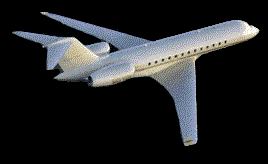 HARD SURFACE 1.755 ' X 130'
|
LFLJ - COURCHEVEL
|
|
|
 HARD SURFACE 1.755 ' X 130'
|
LFLJ - COURCHEVEL
|
|
|
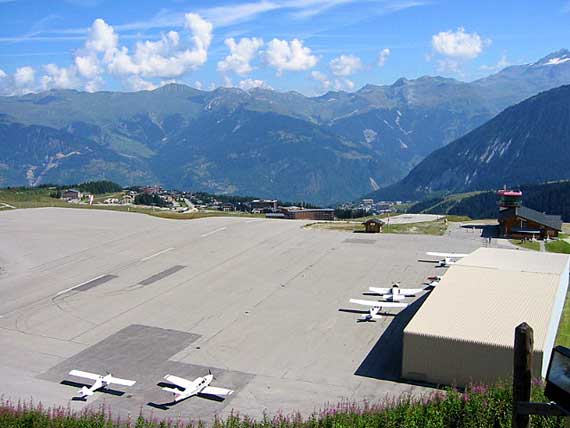

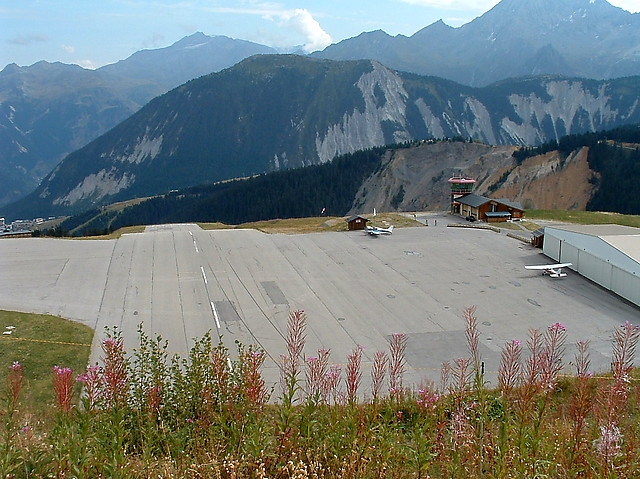
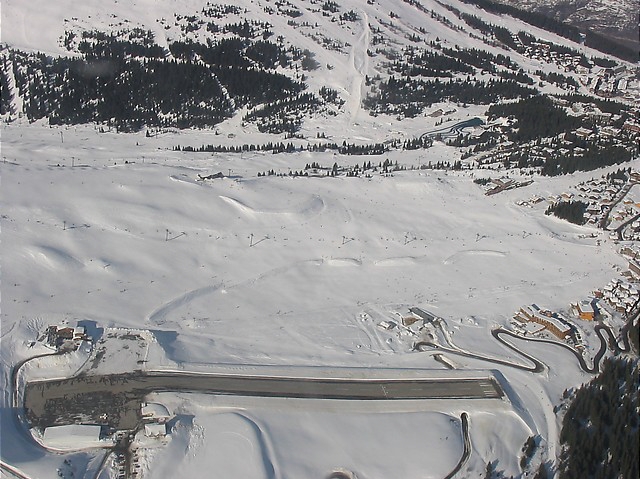
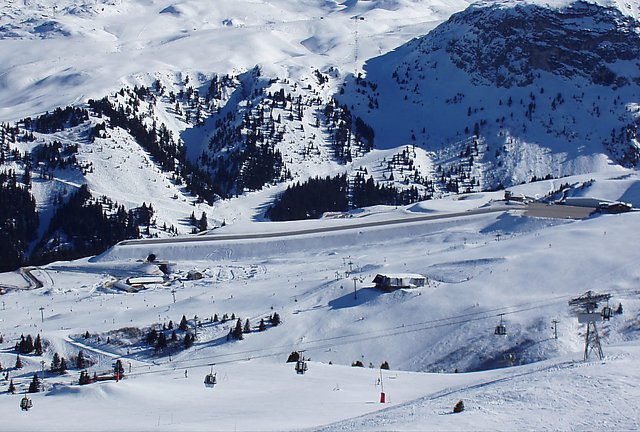

![]()
![]()
![]()
Dash 7 Pilot Training at Courchevel
Article written by Captain Bernt Stolle
| The whine of a PT-6A starting disturbs the otherwise quiet Sunday morning air. Slowly the prop of the #3 engine starts to turn. After the starting sequence 3-4-2-1 is complete, the Dash 7 starts to turn into the direction of runway 26. During the turn, the morning sun glint reflects off its fuselage and wings. Milton's Dash 7 not only captures the exact shape of the real Dash 7, but also its personality. The superb textures are just fitting the crown to this absolute beauty. Flaps are extended to 15 degrees and the big tail majestically swings around as she lines up on the runway. The copilot tries to set exactly the same take-off torque on all four engines (most of the time in vain) before 60kts is reached and the Dash 7 rapidly gathers speed. At VR a fairly large backward movement of the joke is needed to start the rotation and the Dash 7 leaps into the air. After attaining a positive rate of climb, the gear is selected up, and like on the real dash 7, Milton's Dash 7 mirrors its real world counterpart exactly. The main struts slowly retract forward into the nacelles while the nose gear vanishes quickly in the fuselage, as does the tailbumper. Pitch attitude is maintained at 7.5 degrees and at 1000 feet AGL the flaps are retracted. Now the torque and RPM are reduced for climb, and flanked by the mountains, our Dash 7 lazily climbs along the Inn Valley. Shortly after reaching the cruising altitude of 14,000 feet, we pass over Lake Constance and we set course to Chambery, the ultimate destination being Courchevel. It's the annual training for the few pilots that are allowed to fly this 20-ton turboprop into this altiport. We shoot an ILS at Chambery in clean configuration at 200kts, level off at 1500 feet and continue VFR at low level. In case of a bad weather situation this is the only way to find Courchevel.
Courchevel Approach As you turn into the valley where Courchevel is located the tension starts to rise. Finally you spot this tiny runway. Of course we have to make a high speed low pass overhead the airfield first before throwing the Dash 7 into a steep turn for the downwind leg. Due to the combination of roll spoilers and ailerons the roll rate is much higher than one would expect from a four-engine turboprop, a feature Milton's Dash 7 models correctly. |

Figure 1: Courchevel Altiport
| In the downwind the flaps are
extended to 15 degrees and the props go to high RPM. The comforting low
hum turns into an aggressive higher pitched powerful sound. You are
turning directly into the final approach 'cause there is not really enough
space for a base leg. Rolling out on final you look straight into a
seemingly vertical runway. You have to fight the temptation to go below a
2-3 degree glideslope. The gear is extended, than flaps 25 and 45. Lots of nose down trimming with the mechanical trim wheel is required during flap extension. If you are too fast you sometimes even run out of trim. At least the rudder and aileron trim are electric, God knows why. |
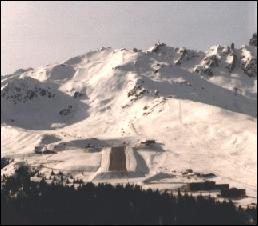
Figure 2: Courchevel on Approach
| Very soon the missed approach point
is passed and you are now committed to land. If you have an engine failure
now, or the runway is blocked, that's bad luck. Tower gives you the last
very important wind information. Under some crosswind conditions you can
experience a rather strong downdraft on final that not only destabilizes
the approach but also exposes the aircraft to the danger of undershooting
the runway. Unfortunately you can't afford that in Courchevel because
ahead of the runway there is nothing but vertically dropping terrain. The
consequences would be the same like a ramp strike at an aircraft carrier.
The fuselage would brake apart. Flaring too far on the other hand isn't a good idea either because the runway isn't really that long and landing in the steep part of the runway can damage and has damaged the landing gear seriously. So you better to get it perfectly right the first time! With that knowledge in your mind, tensions gets really high now as you approach the runway. The copilot now calls out every knot difference from Vref. Suddenly the threshold rushes below the runway, the power levers are slammed back into idle and with a fair amount of backpressure on the yoke the descent rate is being broken. Despite the long stroke landing gear, the touchdown is most of the time a teeth rattling experience. Milton's Dash 7 looks exactly the same way during touchdown. It's incredible how realistic this sequence looks! Now the power levers are brought back into slight reverse and you don't need any brakes. After slowing down to taxi speed you need quite a bit of power to keep the plane moving up the grade. As this is a training session, once you are on the flat part of the runway, you turn around and taxi with reverse on all four engines backwards until the snow banks begin. |
| Courchevel Departure Flaps are set to 25 degrees and the power is increased to 50% torque. Once this has been done the inboard engines go to 100%. Due to the high uneven power setting, you can see the whole plane rocking up and down on the main struts and the propeller wakes hit the large tail so that the whole fuselage shudders and vibrates. |
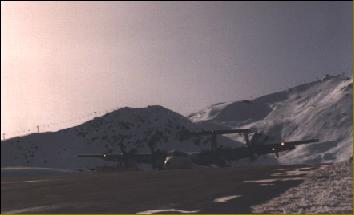
| Figure 3: Dash 7 Readies for Departure |
|
Noise level in the cabin, sitting between the props is really high now. Brakes are released now and at the same moment V1 is being passed. If you want to abort the take-off one second after brake release, it would be too late to stop. You would enter the steep part of the runway and that would mean the end of your possibility to abort the take off. As you enter the steep part now during the take off run, the copilot increases the power on the outboard engines rapidly to100% torque. If this would be done earlier and an outboard engine running at full power would fail before the 'kink', you would simply loose the directional control of the plane. The rudder isn't effective at this low speed and the nose wheel would loose its traction upon entering the steep decline. The copilot now calls out speeds at every 5 knots and upon passing through the shallower part of the runway all three struts compress considerably and after that point rotation is initiated regardless of the speed. If the rotation rate is too slow you get airborne simply because there is no runway left and the main struts drop with a loud thump to their fully extended position. During a 'normal' take-off, you still fly away with about 1000-1500 fpm rate of descent! The left turn into the downwind is immediately begun for the next circuit. After all the pilots have finished their training, we park our Dash-7 for a short while to relax a bit. As the sun begins to settle we are getting ready for our sunset flight into Innsbruck. |
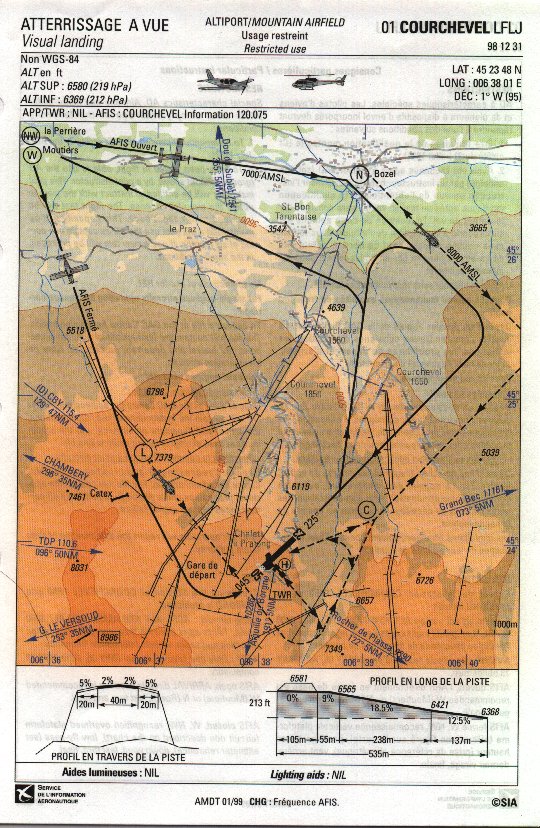
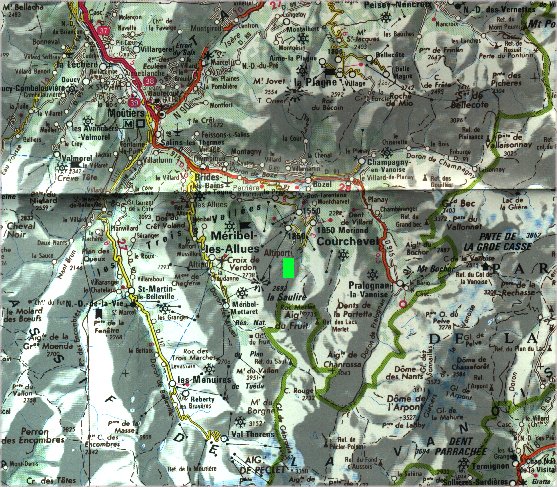
| Type | Altiport |
| Carte VAC | cliquez |
| Coordonnées | 45°23'48" N, 06°38'01" E |
| Localisation | 2km S de Courchevel |
| Carte IGN | cliquez |
| QFU | 230° atterrissage, 050° décollage |
| Tour de piste | main droite |
| Piste | 535 m x 40 m |
| Pente | 18.5% profil régulier |
| Revêtement | enrobé |
| Balisage | non |
| Altitude | bas :
6.370 ft / 1.940 m haut : 6.580 ft / 2.005 m |
| Reconnaissance/circuit | 7.100 ft / 6.900 ft |
| Fréquence | 120.075 |
| Accessibilité | Eté / hiver, déneigé |
| Taxe d'atterrissage | à
payer à la tour taxe de déneigement en hiver (284F) |
| Observations |
survol station interdit s'annoncer à W, NW ou N puis dernier virage |
Les infos utiles
| Météo | Chambéry |
| Gestionnaire plateforme | Mairie 04.79.08.24.14 |
| Carburant | oui |
| Taxi | |
| Restauration/Hébergement | |
| Pour connaître l'état de la plateforme | Altiport 04.79.08.26.02 |
| Aéro-club | Aéro-club
de Courchevel 04.79.08.31.23 |
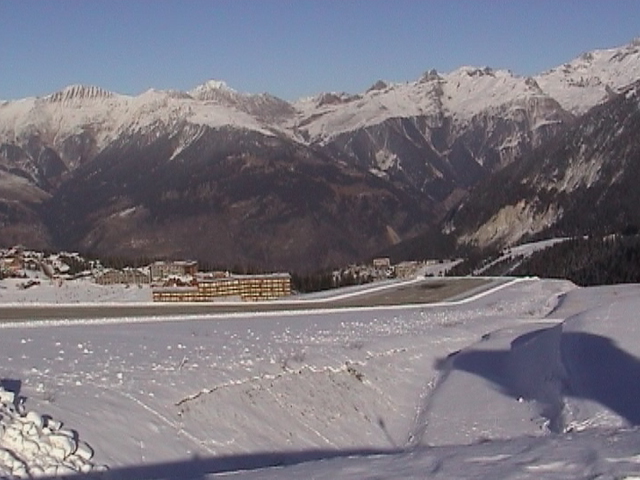
| Date of Visit = December 2001
Pilot: = Howard Gold e-mail = pilot-h@higher.flyer.co.uk Field Report = I have just come back from Courchevel, in the French Alps, where I spent a day and a half gaining my "permission to land at the Altiport" This took about 3.5 hours and was done at the Aero Club des Trois Vallees. The aircraft used is a brand new C172, and the instructor, Robert Christin, is a highly experienced and very charming fellow, an alpine glider pilot and ex Mirage 2000 fighter pilot who does instructing and sight-seeing flights from the remarkable tarmac Ski-Jump runway, which is guaranteed to be kept snow-free.
The appeal of this is not just in the pure thrill of being able to fly in what must be the most spectacular environment in which it is possible to pilot a light aeroplane, but also the fact that it is possible to fly oneself direct from the UK to a place where you can actually take your skis out of the back of the plane, clip them on, and go. Customs and Avgas on site.
My home airfield of Elstree, a little to the north of London, is at a height of 330' AMSL. Our nearest "Mountain Range" is the Chiltern Hills, that great continental divide which separates Southern England from the Midlands. North of that great watershed, who's peaks soar to around 900' AMSL, even the local accent begins to subtly change. These chalk cliffs were once primordial seabeds, bounded by sand deposits left behind when Bedfordshire was a huge golden beach, now many miles from the nearest ocean. The Chilterns demand respect from aviators, especially in bad weather, when, while flying under a low cloudbase, one can be surprised at how suddenly the ground seems to rise up around your wings. The Chilterns even have their own source of Mineral water, so they are indeed mountains! Flying in this environment is about as useful a preparation for alpine flying, as having a sister in the Girl Guides would be to a career in the Royal Marines. Courchevel Altiport elevation is 6581'. The runway however drops from the airfield level down to 6368' at the threshold some 535m away.
In the USA there are many mountain airfields, where low powered aircraft teeter precariously into the air on grossly extended takeoff runs on grossly extended runways. The french however, have decided not to let a simple matter like density altitude get in the way. By simply making the runway follow the slope of the mountain, and decreeing that takeoffs are downhill and landings uphill, gravity is used as a replacement for air molecules. Large twins and even four engine turboprops are able to takeoff and land on a runway which totals 535m (from the drop-off at the bottom to the mountain face at the top) a TODA or LDA which would be marginal if it was at sea level, and flat. But at Courchevel, with varying gradients along the length of the runway (to a maximum of 18.5% for the central 238m) the mere fact that the local QFE on a standard day would be 793mb is no obstacle either to take-off or to landing. It does however put paid once and for all to the argument about always landing on QFE. Just try winding off 6000' from your altimeter as you enter the circuit to see why... Circuits, they are also an interesting thing. The circuit as such is more of a triangle. It is a sort of a visual "procedure turn". To fly a curcuit at Courchevel, you takeoff on runway 05, then as soon as established in the climb you make a left 45 degree turn, climbing to circuit height which is usually 7000', but can also be made as a low level bad weather circuit at 6,600' which is the height of the tarmac at the top of the runway, and actually means that you are flying a curcuit BELOW the control tower!
You maintain this heading until you are over a town on the valley floor several thousand feet below circuit height, this is "Point November" at which you make a right 135 degree turn to set up on a right base for Runway 23.
It is then a matter of waiting until you are ready to turn final (just before you collide with the peak of a mountain which is almost in line with 2-mile finals)
Then you set up a standard 3 degree glideslope, aiming well below the threshold. Continue this descent (which may be with a head/tail/cross wind) until level with the threshold, then flare, plopping down one third way into the initial 137m which has a mild gradient of 12.5%. Then be prepared to ADD power to climb up the next section (the centre section of 18.5% gradient) because if the aeroplane stops, you won't get it started rolling up without someone getting out and pushing. Also there is the possibility of it rolling back..... The top section if 105m is flat, and is level with the parking and hangars - beyond that is the mountain face. In December and January during the afternoons there is an added tingle, the fact that the sun is at such an angle that from turning finals at two miles, to a few hundred metres from the threshold, there is absolutely no vision. You are completely unable to see forwards. The approach is flown exactly like an ILS, with a 3 degree glideslope which, in the 172, equates to about 480 feet/min in nil wind. Unlike an ILS however there are three things missing - the beam bar, the glideslope needle, and the fact that you can always go around if the runway suddenly appears out of the gloom in a place not of your liking. In this case, you fly the runway heading, stick to all the numbers (Speed, power, descent rate) and wait for the threshold to coalesce out of the glare. Better hope it is nicely lined up when it appears because once you see it, you are going to land on it. There are no options.The winter afternoon approach at Courchevel brings new meaning to the expression "Blind faith"
Once you can see the runway, you fix your gaze on a point below the initial threshold, then transfer to the threshold itself, always ignoring the sloping runway above. Otherwise your sense of perspective will give you the wrong impression of your height, and you may be tempted to climb
From about half way into the final approach (depending upon airspeed) you are committed. There is no go-around because there is the rest of the mountain soaring above the altiport, with a climb gradient only a Saturn 5 could tackle, and also there is no room to turn.
Apart from landings and takeoffs, we do some valley flying. Some things I already knew, such as the rule about always flying along one side of a valley, (but never realised just how close this is normally done - it's very exciting to see pine trees filling the right hand window only a few feet away whilst the left has a view dropping 7000' to the valley floor)
I knew the rule about crossing a ridge at an angle to enable a turn back to be made should down-drafts or bad weather compromise the traverse, and to make tight turns you need a high angle of bank and slow airspeed. I also learned that at 12,500' and 80 kts with four adults on board. (!) the C172 stall warner likes to bleep a little in level flight. This was during an extra flight I took as a passenger on a sightseeing tour. The views of Mont Blanc however made it all worthwhile.
After 3.5 hours flying and some ground school I was granted my "permission", and as the sun set a bottle of bubbly was shared amongst the members of the club who'd gathered in the little chalet hut which serves as office, briefing room, pilot's lounge and bar. One of the mountain men in the aero club had given me some sage advice. "In the mountains, never forget how small you are" I understood his french as meaning that one should always remain humble and prudent as a mountain pilot. Despite having had a licence for 20 years, I felt like a complete beginner amongst these experienced mountain aviators, and as I left with proud stamp in my logbook, driving under a starlit sky, OAT -18C. I felt very small indeed. Aero Club des Trois Vallees: Annual Membership 150 Euro Dual per hour 132 Euro all inclusive - In a brand new 172. Telephone 04 79 00 20 64
|